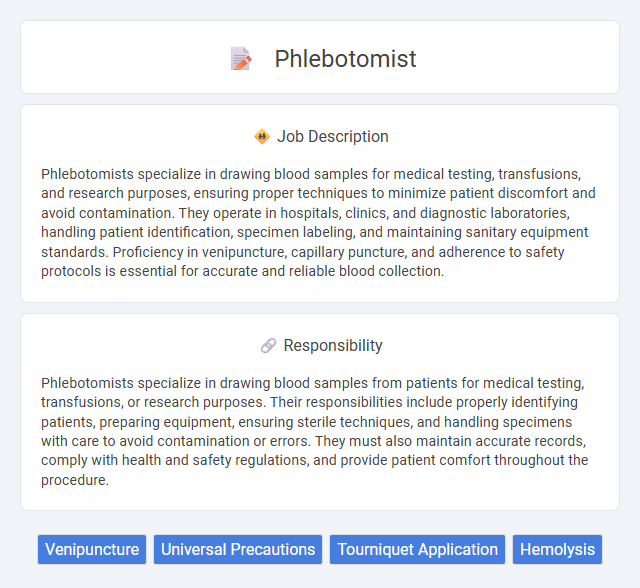
Phlebotomists specialize in drawing blood samples for medical testing, transfusions, and research purposes, ensuring proper techniques to minimize patient discomfort and avoid contamination. They operate in hospitals, clinics, and diagnostic laboratories, handling patient identification, specimen labeling, and maintaining sanitary equipment standards. Proficiency in venipuncture, capillary puncture, and adherence to safety protocols is essential for accurate and reliable blood collection.
People with steady hands, strong attention to detail, and a calm demeanor may be well-suited for a phlebotomist role, as the job involves drawing blood and interacting with patients who can be anxious or uncomfortable. Those who are uncomfortable with needles, blood, or working in clinical settings might find the job challenging to tolerate. The likelihood of success increases for individuals who can handle repetitive tasks, maintain cleanliness standards, and communicate compassionately with diverse patient populations.
Qualification
Phlebotomists require a high school diploma or equivalent and must complete an accredited phlebotomy training program, typically ranging from 4 to 8 months. Certification from organizations such as the National Phlebotomy Association (NPA) or the American Society for Clinical Pathology (ASCP) is often mandatory to ensure proficiency in blood collection techniques and patient safety protocols. Strong knowledge of anatomy, infection control, and specimen handling is essential for meeting industry standards and supporting accurate laboratory diagnostics.
Responsibility
Phlebotomists specialize in drawing blood samples from patients for medical testing, transfusions, or research purposes. Their responsibilities include properly identifying patients, preparing equipment, ensuring sterile techniques, and handling specimens with care to avoid contamination or errors. They must also maintain accurate records, comply with health and safety regulations, and provide patient comfort throughout the procedure.
Benefit
Phlebotomist jobs likely offer benefits such as flexible work schedules and opportunities for career advancement in healthcare settings. Employees may gain valuable skills in patient interaction and laboratory procedures, increasing job marketability. Health benefits and competitive salaries could also be common in this profession.
Challenge
Phlebotomy likely presents challenges associated with patient anxiety and the need for precise technique to avoid complications. The necessity to maintain strict adherence to safety protocols and manage time efficiently under pressure could also be demanding. Success in this role probably depends on strong interpersonal skills and meticulous attention to detail.
Career Advancement
Phlebotomists can advance their careers by gaining specialized certifications such as Certified Phlebotomy Technician (CPT) or Certified Phlebotomy Instructor (CPI), which enhance their qualifications and job prospects. Opportunities for career growth include transitioning into supervisory roles, laboratory technician positions, or healthcare management. Continuous education and experience in clinical settings boost leadership potential and open pathways to advanced healthcare roles.
Key Terms
Venipuncture
Phlebotomists specialize in venipuncture, the precise technique of drawing blood from veins, crucial for diagnostic testing and medical analysis. Mastery of vein selection, needle insertion, and patient comfort ensures accurate sample collection while minimizing complications such as hematoma or hemolysis. Proficient venipuncture contributes to reliable lab results, impacting patient diagnosis and treatment outcomes.
Universal Precautions
Phlebotomists strictly adhere to Universal Precautions, which include using personal protective equipment (PPE) such as gloves and face shields to prevent exposure to bloodborne pathogens. Proper hand hygiene and safe disposal of sharps are essential practices to minimize the risk of contamination or infection during blood collection procedures. Compliance with CDC guidelines on Universal Precautions ensures a safe environment for both patients and healthcare professionals.
Tourniquet Application
A phlebotomist specializes in the tourniquet application technique, crucial for vein identification and blood collection accuracy. Proper tourniquet placement improves vein visibility and reduces patient discomfort during venipuncture procedures. Mastery of this skill enhances specimen quality and minimizes the risks of hemolysis or sample contamination.
Hemolysis
Phlebotomists play a critical role in preventing hemolysis by using proper blood draw techniques and handling specimens carefully to avoid red blood cell rupture. Hemolysis can lead to inaccurate laboratory results, affecting patient diagnosis and treatment. Mastery of proper needle insertion, gentle tube mixing, and timely specimen processing are essential to minimize hemolysis in clinical settings.
 kuljobs.com
kuljobs.com